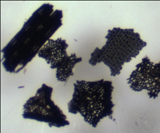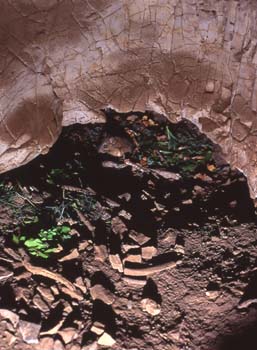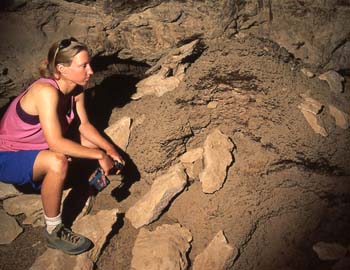Our Methods
Below are some of the tools the RED Lab uses in its research:
Pollen Analysis
Vegetation produces pollen grains, (male spores of seed plants) which are distributed across the landscape and deposited in various environments such as bogs, caves, lakes, and on terrestrial surfaces. If the ultimate location of deposition is suitable for preservation (consistently wet and acidic) pollen are preserved and provide an indication of the types and quantities of plant taxa on the landscape. The extremely acid-resistant sporopollenins found in the morphologically diagnostic exine of the pollen grains are what allow this preservation (Faegri, et. al. 1989).
Pollen analysis is primarily a tool to reconstruct vegetation history from a specific place over time. However, secondary deductions made about climate and disturbance can be concluded through the analysis and interpretation of the pollen record based on known modern environmental conditions for different plant taxa (Faegri, et al. 1989). Vegetation presented in the pollen record serves as indicators of climatic conditions at the time of deposition.
Faegri, K. et. al. 1989. Textbook of Pollen Analysis. The Blackburn Press
Cobabe, Stephanie K., 2004. Pollen grain photographs. University of Utah RED Lab.
Text and photos by Stephanie Cobabe

ONAGRACEAE
Clarkia

PINACEAE
Pinus

ASTERACEAE
Ambrosia

NYCTAGINACEAE
Mirabili

CARYOPHYLLACEAE
Silene

CHENOPODEACEA
Sarcobatus
Charcoal
 Charcoal particles preserved in lake and wetland sediments provide a proxy record
of local and extralocal fire regimes through time. The "geography" of the area reconstructed
using fossil charcoal depends on the size fraction analyzed. Local fire events are
commonly reconstructed using particles >125 microns, whereas regional fire activity
is reconstructed using microscopic charcoal found in pollen preparations (see Whitlock
and Larson, 2002 for a synthesis of this methodology). Most studies, including those
done in the RED Lab, combine charcoal data with pollen data and sedimentary evidence
of erosion fluctuations from the same sediment core in order to examine the connections
between climate, vegetation change, fire, and sometimes human activities in the past.
Charcoal particles preserved in lake and wetland sediments provide a proxy record
of local and extralocal fire regimes through time. The "geography" of the area reconstructed
using fossil charcoal depends on the size fraction analyzed. Local fire events are
commonly reconstructed using particles >125 microns, whereas regional fire activity
is reconstructed using microscopic charcoal found in pollen preparations (see Whitlock
and Larson, 2002 for a synthesis of this methodology). Most studies, including those
done in the RED Lab, combine charcoal data with pollen data and sedimentary evidence
of erosion fluctuations from the same sediment core in order to examine the connections
between climate, vegetation change, fire, and sometimes human activities in the past.
Reconstructions of fire history give us an understanding of the role fire plays on the landscape and the links between climate change and fire regime. Such an understanding is crucial for current ecological restoration efforts and predictions of and preparations for the effects of future climate change.
 METHODS- Macroscopic Charcoal
METHODS- Macroscopic Charcoal
Samples for charcoal analysis are soaked in a disaggregating solution of sodium hexametaphosphate
for at least 48 hours and then washed through nested sieves of mesh size 125 and 250
μm. These size fractions are chosen because it has been shown that particles of this
size indicate local fire events since they do not move far from their source (Clark,
1988; Gardner and Whitlock, 2001; Whitlock and Millspaugh, 1996).The material remaining
in the sieves is then transferred to gridded petri dishes, where the charcoal fragments
are identified and counted using a dissecting microscope. Charcoal accumulation rates
are then calculated from this primary data in order to determine the local fire regime
through time. Conversion of charcoal accumulation rates (CHAR) into fire regime is
done by decomposing the charcoal record into background and peak components. For a
discussion of this methodology, please see Long et al. 1998.
Text and photos by Shawn Blissett
REFERENCES:
Clark, J.S. 1988. Particle motion and the theory of stratigraphic charcoal analysis: source area, transportation, deposition, and sampling. Quaternary Research 30, 81-91.
Gardner, J.J., and Whitlock, C. 2001. Charcoal accumulation following a recent fire in the Cascade Range, northwestern USA, and its relevance for fire-history studies. The Holocene 5, 541-549.
Long, C.J., Whitlock, C., Bartlein, P.J., and Millspaugh, S.H. 1998. A 9000-year fire history from the Oregon Coast Range, based on a high-resolution charcoal study. Canadian Journal of Forest Research, 28: 774-787.
Whitlock, C., and Larson, C. 2001. Charcoal as a Fire Proxy. In Tracking Environmental Change Using Lake Sediments. Volume 3: Terrestrial, Algal, and Siliceous Indicators. J. P. Smol, H. J. B. Birks & W. M. Last (eds.).
Whitlock, C., and Millspaugh, S.H. 1996. Testing the assumptions of fire-history studies: an examination of modern charcoal accumulation in Yellowstone National Park, USA. The Holocene 6, 7-15.
Beetles
Macrofossils are important for lake sediment analyses and provide opportunities to confirm presence at a particular site and also are useful for radiometric dating. While presence of macrofossils can be considered significant, their absence generally is not. However, bark beetles may be a unique exception to this rule.
 When bark beetle populations transition of endemic to epidemic, they become so ubiquitous
on the landscape that quantification of their numbers is difficult. Observations from
forests experiencing epidemic populations of beetles include noting drifts of beetles
along lake shores more than a mile long. Such observations suggest that entrainment
of beetle remains into the depositional sediments of subalpine lakes becomes much
more likely during epidemic outbreaks than during endemic conditions.
When bark beetle populations transition of endemic to epidemic, they become so ubiquitous
on the landscape that quantification of their numbers is difficult. Observations from
forests experiencing epidemic populations of beetles include noting drifts of beetles
along lake shores more than a mile long. Such observations suggest that entrainment
of beetle remains into the depositional sediments of subalpine lakes becomes much
more likely during epidemic outbreaks than during endemic conditions.
The recent occurrence of landscape-scale bark beetle outbreaks throughout subalpine ecosystems of the Western US has lead to a call for a deeper understanding of relationships between bark beetles, climate and forest disturbance. Examining lake sediments in areas that have experienced historically documented bark beetle outbreaks provides research opportunities to calibrate changes in pollen, beetle macrofossils entrainment and charcoal influx (i.e. wildfire events) as recorded in lake sediments.
Calibrated findings from historically documented outbreaks will assist in finding and interpreting similar outbreaks signals from early periods of the Holocene and may provide a more thorough understanding of how climate dynamics may control or influence the severity and spatial structure of epidemic bark beetle outbreaks.
Packrats
Reconstruction of past environments in the arid uplands of the southwestern United States can be difficult. Lakes that preserve long pollen records are rare and ephemeral, often producing only short or fragmentary pollen records. As a result, paleoecologists may employ another tool in the effort to understand past vegetation changes by analyzing materials preserved within woodrat or packrat (Neotoma spp.) middens for reconstruction of much of the vegetation history of the uplands and canyons of the American South west.
The preserved middens of packrats contain a wide variety of micro- and macrobotanical specimens, and may preserve a rich record of the vegetation histories of the many microclimates in which they are found. The variousNeotoma species are consummate collectors of a wide variety of organic floral and faunal materials (Dial and Czaplewski, 1990; Finley, 1958; Van Devender, 1990; Vaughan, 1990). This behavior, when combined with the preservation effect of induration by crystallized packrat urine (Spaulding et al., 1990), has created a rich source for paleoecological study of the last 50,000 years from many sites throughout the arid Southwest (Wells and Jorgensen, 1964; Wells, 1976; Spaulding, 1985; Van Devender and Spaulding, 1979; Mead, 1981). Past environments are reconstructed by the analysis of macro and microbotanical remains, as changes in vegetation (Cole, 1982) preserve details on environmental changes.
Here at the RED Lab we will process, analyze, and curate packrat middens from a variety of paleoenvironmental projects in Utah and the greater Southwest. Currently we are analyzing middens from Range Creek in support of the major archaeological project being directed by Duncan Metcalf of the U's Anthropology Department.
For more information about packrat midden analysis follow the links below:
Past, Recent, and 21st Century Vegetation Change in the Arid Southwest
North American Packrat Midden Database
Text and Photos by Larry Coats

Modern Packrat with Collection


40,000 Year old Midden in Grand Canyon
Magnetic susceptibility (MS) & Loss-on-Ignition (LOI)
Magnetic susceptibility (MS) is a tool used to reconstruct mineralogic input into lake or ciénega systems. Peaks in magnetic susceptibility may indicate a pulse of erosion, most likely a result from a disturbance on the landscape, such as fire.
Loss-on-Ignition (LOI) is used to determine organic and carbonate content in sediments. Percent organic content usually reflects changes in lake or wetland productivity. Percent carbonate reflects changes in groundwater inputs to the system.
Combining MS and LOI with each other and other sedimentological proxy (such as pollen and charcoal) allow us to produce a more comprehensive picture of how a system has changed over time.
References:
Dean, W. E. Jr., 1974. Determination of carbonate and organic matter in calcareous sediments by loss on ignition comparison to other methods. Journal of Sedimentary Petrology 44, 242-248.
